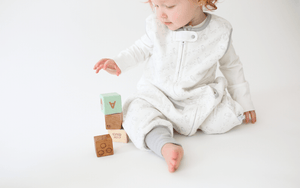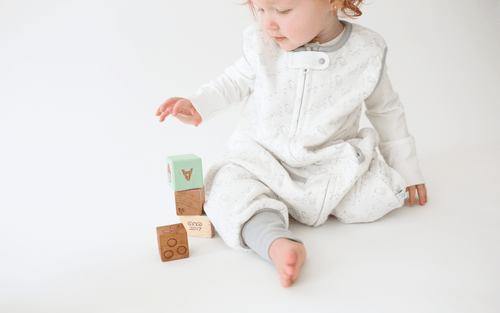How To Solve Short Naps
By: Becca Campbell

There’s nothing more frustrating than laying your baby down for a nap, settling into a work at home rhythm (or catching up on Netflix — yassss) and BAM! Your baby wakes up the moment you get to a second email.
Is a 30 minute nap good enough? Why is your baby taking short naps?
We have asked sleep consultant Becca from Little Z’s to provide us insight on how to help your baby to take longer naps. Becca worked with thousands of families who were frustrated with short naps and these top 3 ways will help prevent short naps from happening:
3 STEPS TO HELP END THE SHORT NAP CYCLE
STEP 1: Ensure your child’s room is 100% dark

You’ve probably heard that the darker the room, the better the sleep. SERIOUSLY, don’t skip this step! Here’s what’s really happening:
You put your baby down for a nap and they fall asleep; their body lifts from one sleep cycle, ready to drift into another... BOOM! The sunlight enters closed eyelids sending a signal to the brain that it’s time to get up!
Want to take a guess on how long that sleep cycle lasts? An average of 30 minutes.
So if you’ve been convinced that your child should learn to sleep anywhere, I get it! You want to have flexibility. But the truth is, if any speck of sunshine is peeking through the room, your child will more than likely wake up after one sleep cycle ready to resume their day.
One of the best solutions for blackout (that can be removed or lifted during the day) are the Blackout EZ Covers. They can easily be cut down to the window size, and are perfect for those odd-shaped decorative windows that may be in your baby’s room.
One of the exercises you can do is walking through the child’s room with the blinds closed, curtains closed and lights off. Sit down, let your eyes adjust to the darkness. If you can see lights coming in through the sides or you can see your hand in front of your face, we need to make a change!
Need something quick before the next nap? You can also try a foil hack here.
Relevant Read:
STEP 2: Is your baby awake enough?

It sounds crazy, but if your baby isn’t awake long enough, then they won’t sleep long enough.
I’ve seen this time and time again with a 7-month-old who is switching to a two nap schedule. Baby has been waking in the morning at 7 a.m., and going down for a 9 a.m. nap. That’s just two hours of wake time, going on for about a month. All of the sudden, baby starts taking 30 minute naps instead of the 1 hour 30 minute naps.
What’s happening? It’s dark...it’s quiet...baby had a great feed...what is going on?!
Awake windows for babies are changing!
Yep! If you aren’t staying on top of your baby’s ever-changing awake windows and schedules, then chances are the short naps are happening because we need to tweak the schedule.
Use this table below for quick reference!

Staying on top of a child’s changing nap schedule can seem exhausting, but trust me. If you *aren’t* keeping up to date on things, the short naps will become exhausting for baby and you!
STEP 3: Don’t rush!
Remember when you had a newborn and YOU woke up throughout the night because of their (cute) grunts, whimpers and coos? Babies are noisy! While they do grow out of many of those little whimpers, we naturally make noises and shift as we sleep.
No one gets into their bed and stays totally still for 8+ hours a night.
It’s very common that as your baby changes from one sleep cycle to another, they may make noises and more than likely will move their body around. Before you rush in because they are “awake” — just watch them!
The beauty of a video monitor is that we can see exactly what is going on! Watch and see.
Is your baby trying to roll over to get cozy again?
Is your baby trying to find their fingers to suck on to soothe themselves?
Is your baby going to let out a few drowsy cries before going back to sleep?
Just wait.
“But how long!?”
This one hundred percent depends on your sleep philosophy and how you have sleep trained your baby.
If your little one knows how to sleep independently, you may need to wait around ten minutes (depending on protest levels) before calling the nap “over.”
If your little one doesn’t know how to independently sleep, you will need to get them up fairly quickly, or get them back to sleep quickly, as they are searching for whomever/whatever it was that helped them sleep in the first place.
Waiting a few minutes to see if your baby is ready to get up, or is going back to sleep, means the difference between a 30 minute nap or a 1.5 hour nap.
It’s powerful to allow your baby space and watch what they will do!
Short naps are so frustrating! It can take as long as four to six weeks, or as soon as the next nap — depending on where your family is in the sleep journey.
As you’re reading this, it’s super easy to implement these 3 steps before the next naptime.
Head to your child’s room and check the darkness level
Keep them awake long enough so they can sleep long enough
Don’t rush right in. Wait to see how your baby may be trying to self-soothe
Most of all, don’t just blindly work on short naps. Use a sleep log to keep track of your child’s nap progress. It may seem tedious, but you’ll be so encouraged by small wins as you work on these short naps and make progress.
Sweet dreams are coming soon!
Relevant Read:
- Baby's Sleep Explained - Why Do They Wake Up So Often
- What is TOG? And What Thickness Sleeping Bag Do I Need For My Baby?
Written by Becca Campbell, Owner of Little Z's






















